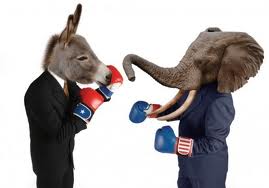Sharpening
“Sharpening” and “softening” are two opposite techniques we can use to steer psychodynamic forces within groups. Both techniques can be applied skillfully or unskillfully to influence or manipulate behavior and experience.
“Sharpening” is accomplished by intentionally exaggerating individual differences while minimizing or ignoring what we have in common. In college, I had a black sociology professor who began our first class with this statement: “if you are white, you are, by definition, a racist.”
Man, did he get my attention! The primary effect of sharpening is to raise tension in groups. He had the whole class in rapt silence, and he knew it. His statement divided us into an insurmountable we/they, and I was ready to go to battle with him. The eyes and ears of the class were upon him like a laser.
He had reduced me from a guy (just like him,) a member of that same college community (just like him,) someone who had experienced rejection or exclusion (just like him,) and someone who loved learning (just like him) to “that white racist kid in the back of the class vs. the black professor in the front.”
 Other examples of sharpening are statements like “our political party cares about this country while the other party only cares about their own selfish concerns.” The truth (the thing we have in common) is that there are people in both parties who are selfish and people in both parties who care about society as a whole, and the greater truth is that most of us have both parts within ourselves. Each of us can be altruistic, and at other times, selfish.
Other examples of sharpening are statements like “our political party cares about this country while the other party only cares about their own selfish concerns.” The truth (the thing we have in common) is that there are people in both parties who are selfish and people in both parties who care about society as a whole, and the greater truth is that most of us have both parts within ourselves. Each of us can be altruistic, and at other times, selfish.
Most people in most political parties have most things in common; we might agree on all the important things there are to agree on. Children should be loved, people should have enough to eat, everyone wants to be happy, people shouldn’t hit each other, etc. Most people agree on most of the things there are to agree on. If you look at the giant sum total of everything there is to question in life, we have relatively small disagreements on a relatively small number of things, and that gets exaggerated and built up when we apply sharpening techniques.
 Dividing people into Democrats and Republicans is an example of a sharpening technique. (Very few people are 100 percent one or the other, or agree with 100 percent of everything in a platform, but by forcing people into two boxes–and notice, not three or four, but two–we exaggerate our differences and increase tension.)
Dividing people into Democrats and Republicans is an example of a sharpening technique. (Very few people are 100 percent one or the other, or agree with 100 percent of everything in a platform, but by forcing people into two boxes–and notice, not three or four, but two–we exaggerate our differences and increase tension.)
Dividing men into gay and straight is a sharpening technique; very few are 100 percent one or the other for their entire lives. Dividing people into “religious and not religious” is a sharpening technique; there are a variety of levels and degrees of engagement with spiritual practice, and practice takes many different forms of expression.
So why sharpen? Sharpening increases tension! And what’s the benefit of increased tension? Money! Sharpening sells things. Tension = attention = viewers = market share. If you want to sell something, increase tension.
In a mediated society, it is essential to sharpen dialogue constantly to get people to keep tuning in, watching breathlessly as one side takes over the other, then back again, watching to see which side of a false duality is ultimately going to win. Will good prevail over evil, or will evil win the day? (Neither: we all carry both. Most of us are not simply good or evil, but rather good and evil. We’re complete beings, fully alive.) Sharpening makes an ordinary dialogue “bigger than life” by increasing the tension, making it seem like a life-and-death conversation.
 You can see sharpening techniques on pseudo “interview” shows where the interviewer will put a guest on the hot seat, let them get halfway through their second sentence, and then interrupt them with “well your opponent claims just the opposite; what do you make of that?” No interviewer in his or her right mind would say, “why don’t we begin with a list of everything you and your opponent agree on, the things you have in common, the things you both support, and we’ll build the conversation from there.” I bet you’ve never seen that in your whole life.
You can see sharpening techniques on pseudo “interview” shows where the interviewer will put a guest on the hot seat, let them get halfway through their second sentence, and then interrupt them with “well your opponent claims just the opposite; what do you make of that?” No interviewer in his or her right mind would say, “why don’t we begin with a list of everything you and your opponent agree on, the things you have in common, the things you both support, and we’ll build the conversation from there.” I bet you’ve never seen that in your whole life.
Would that be a good technique for our country? Yes! Would it be good for the market share of that particular station? No! It’d be horrible for revenue. If management is paying attention they would fire the interviewer. News programs don’t exist for the good of the country; they exist for profit, and profit benefits from sharpening because it increases tension, and therefore attention.
If you pay close attention you notice that every presidential race in recent memory has hung very very close to 50/50 for most of the time. You’ll also notice that the Republican/Democrat balance in the senate has been “close enough” to 50/50, and that, with uncanny timing, if we somehow elect a congress that has much more than 50 percent of one party, we elect a president from the other party. Then, we’ll surely reverse if congress starts to move in the other direction; we’ll swing back to a President from the other party. We virtually always find ourselves tied 50/50. Why is that? Is it because we truly cannot find a single candidate that everyone agrees would be a better choice for the job? We truly cannot find one idea that we’re not split 50/50 on? We can’t even make it to 60 percent? Really?
The truth is you could run a gerbil against a hamster for the presidency, and the polling would be as close to 50/50 as it always is. We do it to ourselves, and we do it because we like it that way.
 More accurately: our media do it for us, using sharpening techniques, and we encourage them or even beg them to do it for us by the way we modify our behavior in response. Sharpening creates a certain number of winners, in the end: we have exciting, unpredictable lives, media make profit, and no one can say they were bored by a predictable outcome. There’s tension; it’s exciting. The tension results from sharpening.
More accurately: our media do it for us, using sharpening techniques, and we encourage them or even beg them to do it for us by the way we modify our behavior in response. Sharpening creates a certain number of winners, in the end: we have exciting, unpredictable lives, media make profit, and no one can say they were bored by a predictable outcome. There’s tension; it’s exciting. The tension results from sharpening.
(During the Obama/McCain election, domestic polling on “who do you think is more qualified to be president” hovered right around 50/50 the entire time. That’s where it would hover if you ran a hamster against a gerbil. However, during the same election, overseas polling in Europe and Africa on the same question, on average, was closer to 70/30.)
There isn’t anything going on here without our full consent and participation as a nation of individuals. Most people simply don’t notice, or watch for, or “call out” and reject the sharpening techniques that we accept for our national dialogue, but in the end, most of what sharpening techniques do is increase the tension in groups.
So, congratulations. Together, we have managed to ratchet the tension level through the ceiling. Don’t blame “them.” Blame me, blame you. We do it together. At least it produces lots of profit.
Now this crazy interview technique of starting a discussion with what we all have in common? That’s called “softening.” “Softening” is the technique of intentionally exaggerating what we all have in common, while minimizing or ignoring our differences. The primary impact of softening in groups is to reduce tension. Softening is the exact opposite of sharpening and has the exact opposite effect.
 Softening makes groups less combative, less tense, and in some ways less focused. If you sharpened a group to an extreme degree you’d probably end up with physical violence. If you soften a group to the same degree, everyone would fall asleep.
Softening makes groups less combative, less tense, and in some ways less focused. If you sharpened a group to an extreme degree you’d probably end up with physical violence. If you soften a group to the same degree, everyone would fall asleep.
Examples of softening are groups like PFLAG. Instead of dividing the world into “you’re gay or you’re not,” groups like PFLAG emphasize what we all have in common–family, friendship, the need to be loved, and the common experience of finding out someone we love is gay. Any truly bipartisan political group (and I say truly, because some groups that call themselves bipartisan are just posing) will use softening techniques–they will begin by focusing what we have in common, perhaps even exaggerating that slightly, and they will abstain from getting stuck on what differences we have. Some topics might not even be discussed in such groups because they are seen as “divisive” topics which could derail the effort to soften and emphasize commonalities.
In groups that employ softening techniques fairly regularly, you will notice that governance systems like consensus and modified consensus frequently emerge, because the energy of the group is largely focused on “how do we find a way to something in common.” In groups that overuse sharpening techniques, on the other hand, you’ll see a rather ruthless focus on “how do we use what divides us.” And you’ll notice that people exaggerate the differences, and lie if necessary, to get to a place where “most people are like us, and then there are those others, who are different.” And so you’ll see simply majority systems like our Congress, for example, where there isn’t much energy placed on “where can we all agree,” but rather, “how can I score a win for the people like us, preferably while demonizing the other.”
Don’t waste your time with me trying to convince me that one party does this more than the other; I don’t see it. It’s systemic, not party-specific. It comes from human group dynamics, not party dynamics. It impacts everyone. And I’m sorry to say it again, but it is like this only because we like it like that; we tolerate it, we encourage it, and we support it. Sharpening turns us on. It feeds our need for constant arousal.
In Touch Practice, we use softening, exclusively, often, and to powerful effect. It is the primary tool for building the work either with individuals or groups. One of the first things we do in Touch Practice is leave our labels at the door. Liberal, conservative, Democrat, Republican, Christian, Muslim, atheist, gay, straight, married, single, celibate, promiscuous, these things are completely irrelevant in Touch Practice. People in all of those categories need to be held, they all deserve to be held, and it’s the same work.
The techniques for holding someone who is Democrat vs. holding a Republican are exactly the same. I don’t need to know what your “beliefs” are to hold you, and in fact, I can do a better job of holding you if I never know. It keeps the work clearer. It doesn’t matter.
And the impact of softening on group dynamics, where its primary impact is to reduce tension, is welcome and necessary in Touch Practice. When we stop categorizing, we stop making the judgments necessary both to accomplish the categorization and then to evaluate it. (Someone who figures out that you’re a conservative Democrat, for example, will first devote significant energy to making that determination, and then will devote subsequent assessment energy in a process called “attribution”–what does this mean for my relationship with this person, what can I expect, what is likely to happen.)
We don’t expend any of that energy in Touch Practice, ideally, if we are consciously practicing softening, because we don’t want to know what the labels are, and don’t need to figure out what they mean.
Watch for the techniques of sharpening this week, in the national dialogue, in commercials and advertising, watch for the constant way in which we label things into binaries (“you don’t want to be part of THIS group do you? Well join THAT group by buying (or by voting)….”) You’ll see it many times every day. It’s great for engaging a bunch of 7 year olds in storytime, and it might very well have been a useful technique for my college professor in starting off a class full of sleepy-ass freshmen with a bang. When it comes time to move together as a group, however, time to reduce the tension level, promote relaxation and a sense of wellbeing with each other, the technique of softening may be just the thing you’re looking for.
Have thoughts you’d like to share?
Touch Practice is a sacred practice for me, and part of that is keeping confidences sacred. While a name and e-mail address are required to post a comment, feel free to use just your first name, or a pseudonym if you wish. Your e-mail address will never be seen by or shared with anyone. It is used to prevent spam and inappropriate comments from appearing in the blog. I’d really like to hear from you!














What great discernment you have.
We really need more cooperation and less competition.
We need to teach kids how to play cooperatively, for they are learning excessive competition ‘ethics’ from early childhood.
Thanks, Wilhelm. Glad to hear from you and have your comment.